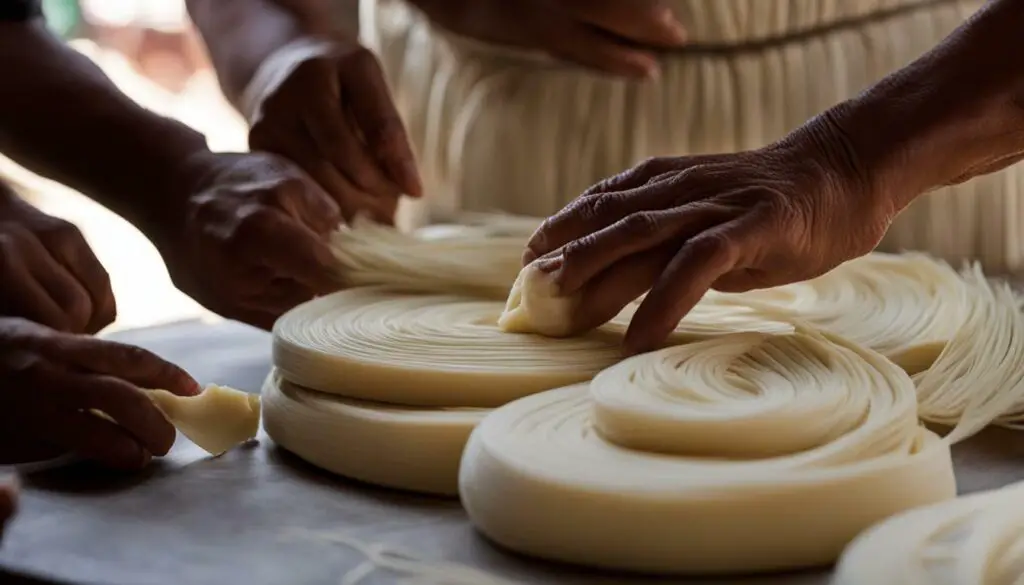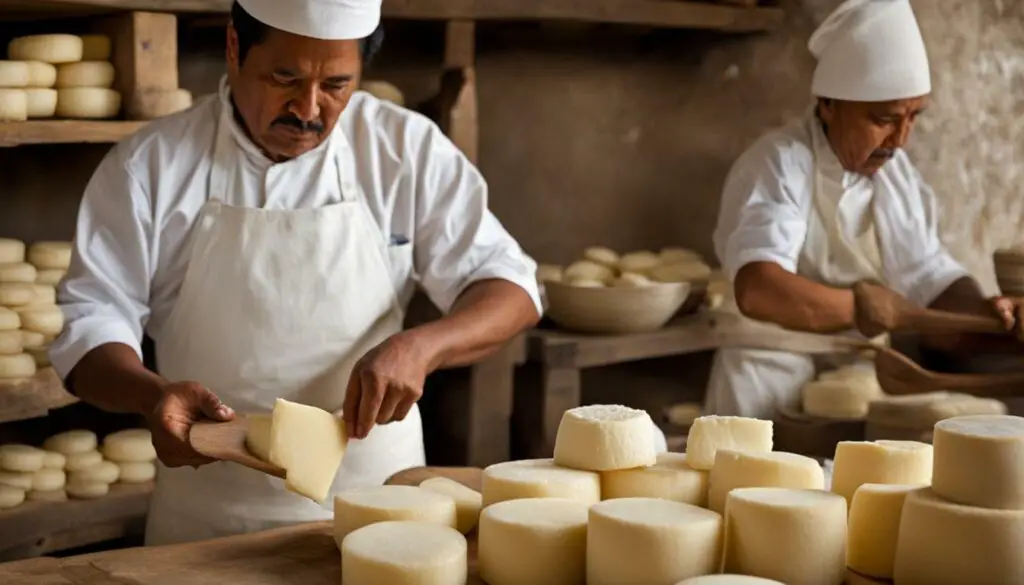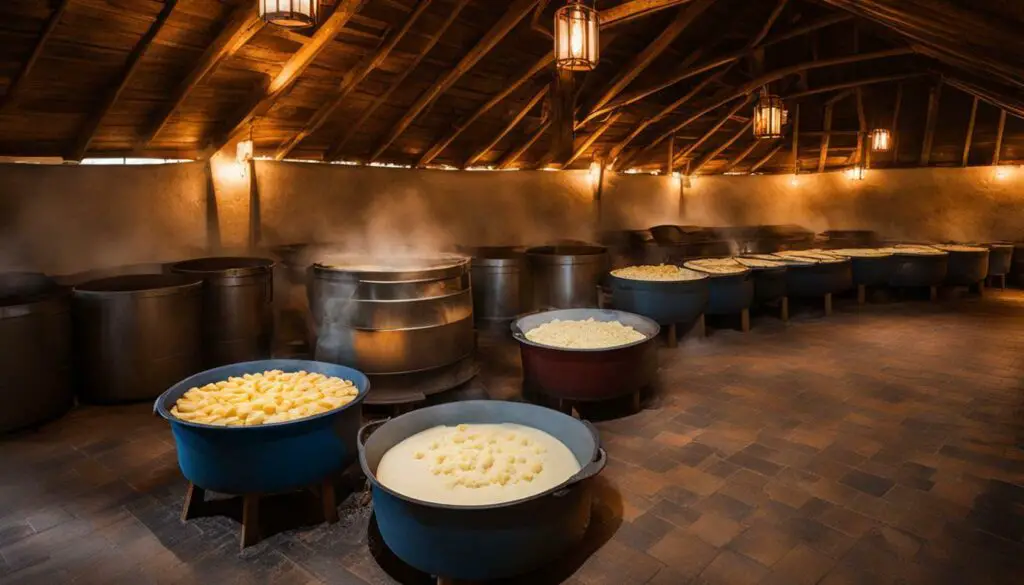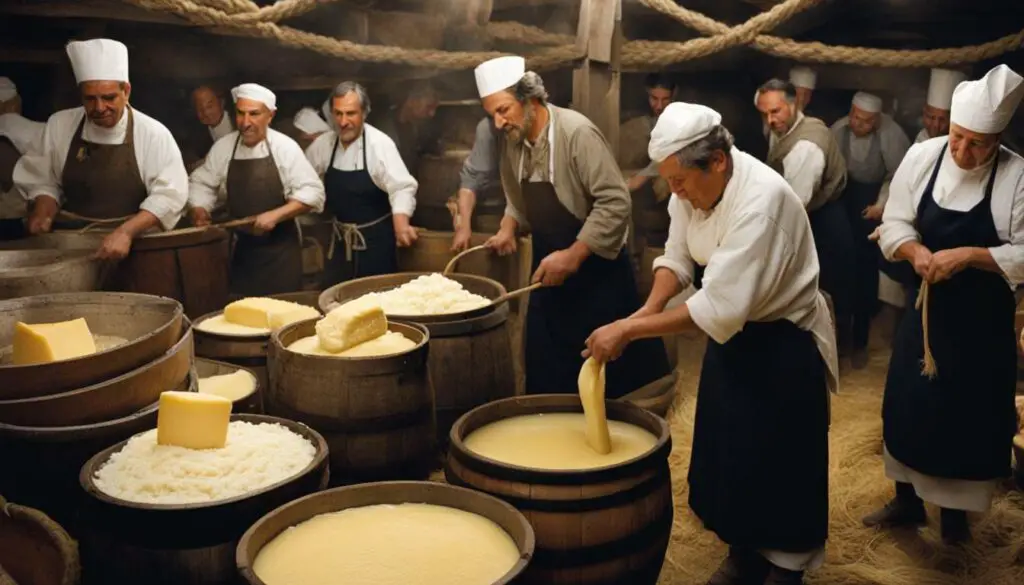Oaxaca cheese, also known as quesillo, is a traditional Mexican cheese with a unique production process. It is widely used in Mexican cuisine, known for its stringy texture and melting properties. Let’s take a closer look at the traditional craftsmanship and production methods behind this beloved cheese.
The production of Oaxaca cheese involves curdling a mixture of fresh milk and sour milk. The curd is then cut into cubes and heated with scalding hot water. This mixture is melted and stretched until it forms long strings, which are then rolled up into characteristic cheese balls. The result is a cheese that is both visually captivating and deliciously creamy.
However, the traditional craftsmanship of making Oaxaca cheese is at risk due to the availability of cheaper, industrially produced versions. Local communities, such as Reyes Etla in Oaxaca, are known for their handcrafted quesillo, but they face challenges in preserving their unique methods. The lack of support and high production costs make it difficult for these producers to compete with larger brands.
Oaxaca cheese plays a pivotal role in Mexican gastronomy, with its versatility and distinct flavor enhancing a variety of dishes. It is a staple ingredient in popular dishes like quesadillas, tortas, and tlayudas. The cheese can be melted to create ooey-gooey queso fundido, and it adds a creamy touch to stews, chiles rellenos, enchiladas, and chilaquiles.
Similar to mozzarella, Oaxaca cheese boasts excellent melting properties, making it an ideal choice for pizzas, grilled sandwiches, and pasta dishes. While mozzarella is made with buffalo milk, Oaxaca cheese is made with cow’s milk, resulting in a slightly different texture and flavor. Both cheeses can be used interchangeably, but Oaxaca cheese brings a unique touch to traditional Mexican recipes.
Key Takeaways:
Contents
- 1 The Traditional Craftsmanship of Oaxaca Cheese Making
- 2 The Role of Reyes Etla in Oaxaca Cheese Production
- 3 Oaxaca Cheese’s Culinary Versatility
- 4 Conclusion
- 5 FAQ
- 5.1 Q: How is Oaxaca cheese made?
- 5.2 Q: What is the traditional craftsmanship of Oaxaca cheese making?
- 5.3 Q: What is the role of the Reyes Etla community in Oaxaca cheese production?
- 5.4 Q: What are the culinary uses of Oaxaca cheese?
- 5.5 Q: How does Oaxaca cheese compare to mozzarella?
- 5.6 Q: Where can I find Oaxaca cheese and what can I substitute it with?
- 5.7 Q: What is the cultural significance of Oaxaca cheese?
- Oaxaca cheese, also known as quesillo, is a traditional Mexican cheese made through a unique production process.
- The cheese is crafted by curdling a mixture of fresh and sour milk, which is then stretched and rolled into characteristic cheese balls.
- Reyes Etla in Oaxaca is a community known for its handcrafted quesillo, but they face challenges in preserving their traditional methods.
- Oaxaca cheese is a versatile ingredient used in various Mexican dishes, such as quesadillas, tortas, and tlayudas.
- It can be substituted with mozzarella or other cheeses with similar melting properties if unavailable.
Explore the unique flavors and cultural significance of Oaxaca cheese on a gastronomic journey, as you savor its creamy textures and indulge in the rich heritage of Mexican cuisine.
The Traditional Craftsmanship of Oaxaca Cheese Making
The production of Oaxaca cheese involves a meticulous process that showcases the artistry and craftsmanship of traditional cheese making. This beloved Mexican cheese, also known as quesillo, is made with a careful combination of fresh milk and sour milk. The curdled mixture is then cut into cubes and immersed in scalding hot water, where it is melted down to a molten state.
Once the cheese is melted, it is stretched and worked by hand until it forms long, stretchy strings. This unique technique gives Oaxaca cheese its characteristic texture and appearance. The elongated strings of cheese are then rolled up into small balls, which are often braided or shaped into knots. This intricate process requires precision and skill, as the cheese must be handled delicately to achieve the desired consistency.
The traditional craftsmanship of Oaxaca cheese making has been passed down through generations, with each cheesemaker adding their own touch and expertise. However, with the rise of industrialized cheese production, the art of making handcrafted Oaxaca cheese is at risk. Commercial versions of Oaxaca cheese are often mass-produced, using shortcuts that sacrifice the unique qualities and flavors of the traditional cheese.
To preserve the authentic taste and craftsmanship of Oaxaca cheese, it is important to support local producers who continue to use traditional methods. By choosing handcrafted Oaxaca cheese, you not only savor the flavors of this gastronomic delight but also contribute to the preservation of an age-old tradition.

“The traditional craftsmanship of Oaxaca cheese making has been passed down through generations, with each cheesemaker adding their own touch and expertise.”
The Role of Reyes Etla in Oaxaca Cheese Production
Reyes Etla, a community in Mexico, is renowned for its expertise in crafting authentic Oaxaca cheese. This small town nestled in the state of Oaxaca is known for its traditional and artisanal approach to cheese production. The locals take great pride in preserving the centuries-old crafting techniques that have been passed down through generations.
In Reyes Etla, the production of Oaxaca cheese is a labor-intensive process that involves utmost care and attention to detail. The artisans source fresh cow’s milk from local farms, ensuring the quality and flavor of the cheese. The milk is then curdled and heated, forming the base for the distinctive taste and texture of Oaxaca cheese.
The craftsmen in Reyes Etla employ unique techniques to mold the cheese, giving it its characteristic shape and texture. They skillfully stretch and knead the cheese until it forms thin strings, which are then rolled and shaped into the traditional Oaxaca cheese balls. This hands-on approach and dedication to craftsmanship result in a cheese that is rich in flavor and truly representative of its cultural heritage.
The challenges and future of artisanal Oaxaca cheese production in Reyes Etla
- The rise of industrialized cheese production poses a significant threat to the artisanal methods employed in Reyes Etla. The mass-produced alternatives, although more cost-effective and efficient, fail to capture the unique essence of traditional Oaxaca cheese.
- Lack of support from agricultural and livestock associations in Oaxaca further exacerbates the challenges faced by local producers. The high production costs and limited market reach make it difficult for artisans to sustain their craft and livelihood.
- Despite the obstacles, there is hope for the future of artisanal Oaxaca cheese production in Reyes Etla. Efforts are being made to raise awareness and promote the value of these traditional crafting techniques. By supporting local artisans and seeking out authentic Oaxaca cheese, we can help preserve this gastronomic treasure for generations to come.

Reyes Etla stands as a testament to the artistry and dedication of those who uphold the traditions of Oaxaca cheese production. Through their craftsmanship, they weave a story of heritage and flavor that is a true delight for the senses. Let us cherish and support the artisans of Reyes Etla as they continue to preserve the cultural significance of Oaxaca cheese.
Oaxaca Cheese’s Culinary Versatility
Oaxaca cheese is a versatile ingredient that adds a rich, creamy flavor to a wide range of traditional Mexican dishes. Its unique melting properties make it perfect for quesadillas, tortas, and tlayudas, where it can be melted and stretched to create a stringy texture that enhances the overall taste. Whether used as a topping or a filling, Oaxaca cheese brings a distinctive flavor that complements the other ingredients, creating a harmonious balance of flavors in every bite.
In addition to its melting capabilities, Oaxaca cheese is also commonly used in stews, such as chiles rellenos, where it adds a creamy element that balances the spiciness of the dish. It is also popular in gratin dishes like enchiladas and chilaquiles, where its soft and stretchy texture creates a delightful contrast to the crispy tortilla chips or the thick corn tortillas. Furthermore, Oaxaca cheese is often melted to make queso fundido, a Mexican fondue-like dish that is typically served with chorizo or mushrooms, bringing a gooey and indulgent experience to the table.
Recipes using Oaxaca Cheese:
- Quesadillas: Fill corn or flour tortillas with Oaxaca cheese and your choice of fillings such as grilled vegetables, shredded chicken, or sautéed mushrooms. Cook until the cheese melts and the tortilla is crispy.
- Tlayudas: Assemble large corn tortillas with refried beans, Oaxaca cheese, avocado slices, and your favorite toppings such as grilled meat, salsa, and lettuce. Fold in half and grill until the cheese melts and the tortilla is crispy.
- Chiles Rellenos: Stuff roasted poblano peppers with Oaxaca cheese and then dip them in egg batter before frying until golden and crispy. Serve with tomato sauce or salsa.
So, whether you’re enjoying the stretchiness of Oaxaca cheese in a quesadilla or savoring its creaminess in a stew, this versatile cheese is sure to tantalize your taste buds and elevate your culinary experience. Try incorporating Oaxaca cheese into your next Mexican-inspired meal and embark on a gastronomic journey that celebrates the rich flavors of authentic Mexican cuisine.

While Oaxaca cheese shares similarities with mozzarella, there are distinct differences that make each cheese unique.
Oaxaca cheese, known for its stringy texture and mild flavor, is made from cow’s milk and is a staple in Mexican cuisine. On the other hand, mozzarella is traditionally made from buffalo milk and has a softer, spongy texture. Both cheeses have a melting quality that makes them ideal for pizzas, lasagnas, and other dishes.
One notable difference between Oaxaca cheese and mozzarella is their origins. Oaxaca cheese originated in the Oaxaca region of Mexico, while mozzarella is an Italian cheese that has gained popularity worldwide. This difference in origin contributes to variations in taste and cultural significance.
“Oaxaca cheese, with its distinctive stringy texture, adds a unique touch to traditional Mexican dishes, while mozzarella’s smooth and creamy consistency enhances the flavors of Italian cuisine.”
Similarities:
- Both cheeses have a mild flavor that complements a variety of dishes.
- They are both versatile cheeses that can be eaten fresh or melted.
- Both cheeses are used in popular dishes like pizzas, sandwiches, and pasta.
- They have a stretchy texture when melted, making them perfect for gooey, melty dishes.
Differences:
- Oaxaca cheese is made from cow’s milk, while mozzarella is traditionally made from buffalo milk.
- Oaxaca cheese has a stringier, more elastic texture, while mozzarella is softer and more pliable.
- They have different cultural significances and are used in distinct regional cuisines.
When it comes to trying these cheeses, it’s recommended to explore the flavors and textures of both. Incorporate Oaxaca cheese into your Mexican-inspired dishes to enhance their authenticity, and use mozzarella to create classic Italian-inspired dishes. The unique qualities of each cheese add depth and complexity to culinary creations.

To experience the true taste of Oaxaca cheese, it is recommended to source it from local markets or Mexican/Latin American grocery stores. These places often carry authentic, high-quality Oaxaca cheese that is made using traditional methods. Buying from local markets not only ensures the freshness of the cheese but also supports local producers who are dedicated to preserving the artisanal craftsmanship.
When shopping for Oaxaca cheese, look for cheese that is white, stringy, and soft in texture. It should have a mild, slightly salty flavor with hints of butter. The cheese should be tightly wound into a ball or shaped into a braid-like form. Avoid cheese that is excessively dry, discolored, or has a strong odor, as these may be signs of poor quality or spoilage.
If Oaxaca cheese is not available, there are suitable substitutes that can be used in its place. Mozzarella, string cheese, queso asadero, and Monterey Jack are all good alternatives. These cheeses have similar melting properties and can be used in recipes that call for Oaxaca cheese. However, keep in mind that each substitute may have its own unique flavor profile, so the taste may vary slightly.
Substitutes for Oaxaca Cheese:
- Mozzarella
- String cheese
- Queso asadero
- Monterey Jack
Whether you’re making traditional Mexican dishes like quesadillas, tortas, or tlayudas, or experimenting with new recipes, Oaxaca cheese adds a distinct flavor and creamy texture to your culinary creations. So, make sure to get your hands on some authentic Oaxaca cheese and enjoy the rich gastronomic experience it offers!

Oaxaca cheese holds a special place in Mexican gastronomy, adding a distinct flavor and texture to a variety of beloved dishes. This traditional cheese is deeply embedded in the culinary heritage of Oaxaca, a region renowned for its rich and diverse cuisine. The cultural importance of Oaxaca cheese extends beyond its role as a staple ingredient; it represents centuries of culinary tradition and craftsmanship.
Handcrafted with care, Oaxaca cheese embodies the pride and passion of the local producers who meticulously follow the traditional methods of production. The cheese-making process has been passed down through generations, preserving the techniques and flavors that make Oaxaca cheese unique. Its soft, creamy texture and delicate stringiness add a touch of indulgence to dishes, elevating them to new heights of gastronomic delight.
In Mexican cuisine, Oaxaca cheese is an essential ingredient in iconic dishes such as quesadillas, a favorite street food enjoyed by locals and visitors alike. Its ability to melt into a gooey, stretchy consistency makes it perfect for quesadilla fillings. The cheese also enhances the flavors of tortas, tlayudas, and a variety of gratin dishes, adding a creamy and savory dimension to the overall taste profile.

Oaxaca cheese is more than just a culinary delight; it represents the cultural heritage and pride of the Oaxacan people. It is a testament to their commitment to preserving traditional craftsmanship and supporting local communities. By savoring the flavors of Oaxaca cheese, we not only indulge in a gastronomic journey but also contribute to the preservation of a cherished cultural tradition.
Conclusion
As we conclude our gastronomic journey into the world of Oaxaca cheese, we are reminded of its unique craftsmanship and its significance in Mexican culinary heritage.
Oaxaca cheese, also known as quesillo, is a traditional Mexican cheese that is made using a distinctive production process. It involves curdling a mixture of fresh milk and sour milk, then cutting it into cubes and melting it with scalding hot water. The melted cheese is then stretched into long strings and rolled up into characteristic cheese balls. The traditional craftsmanship and knowledge of making Oaxaca cheese is at risk due to the availability of cheaper and faster industrialized versions.
The community of Reyes Etla in Mexico is renowned for producing handcrafted quesillo, which serves as their primary source of income. They use locally sourced cow’s milk and make the curd at improvised home workshops. However, the lack of support from agricultural and livestock associations in Oaxaca, along with high production costs, poses challenges for local producers in competing with larger brands. As a result, the consumption of handcrafted quesillo has become a custom limited to connoisseurs and tourists.
Oaxaca cheese is an essential ingredient in Mexican gastronomy and can be found in popular dishes such as quesadillas, tortas, and tlayudas. It is versatile and can be used in stews, chiles rellenos, and gratin dishes like enchiladas and chilaquiles. The cheese is also frequently melted to create queso fundido, a Mexican fondue-like dish often served with chorizo or mushrooms.
Oaxaca cheese shares similarities with mozzarella in terms of melting properties and versatility. However, it is made with cow’s milk instead of buffalo milk, as is traditional for mozzarella. Oaxaca cheese has a white, stringy, and soft texture, while mozzarella is spongy. Both cheeses can be used fresh or melted in various dishes.
To fully enjoy the flavors of Oaxaca cheese, it is recommended to purchase it from local markets in Oaxaca or Mexican/Latin American grocery stores. If Oaxaca cheese is not available, suitable substitutes include mozzarella, string cheese, queso asadero, or Monterey Jack.
In conclusion, Oaxaca cheese is a remarkable and flavorful cheese that holds a special place in Mexican cuisine. Its production process and traditional craftsmanship make it a gastronomic journey worth exploring. Let’s savor the unique taste of Oaxaca cheese and appreciate its cultural and culinary significance.
FAQ
Q: How is Oaxaca cheese made?
A: Oaxaca cheese is made by curdling a mixture of fresh milk and sour milk, which is then cut into cubes and melted with scalding hot water. The melted cheese is stretched until it forms long strings and then rolled up into characteristic cheese balls.
Q: What is the traditional craftsmanship of Oaxaca cheese making?
A: The traditional craftsmanship of Oaxaca cheese making involves the step-by-step process of curdling the milk, cutting it into cubes, melting it with scalding hot water, stretching it into strings, and rolling it into cheese balls.
Q: What is the role of the Reyes Etla community in Oaxaca cheese production?
A: The Reyes Etla community in Oaxaca is known for producing handcrafted Oaxaca cheese, which is their main source of income. They use local cow’s milk and make the curd at improvised home workshops.
Q: What are the culinary uses of Oaxaca cheese?
A: Oaxaca cheese is used in dishes like quesadillas, tortas, tlayudas, stews, chiles rellenos, enchiladas, chilaquiles, and is melted to make queso fundido.
Q: How does Oaxaca cheese compare to mozzarella?
A: Oaxaca cheese is similar to mozzarella in terms of melting properties and versatility. However, it is made with cow’s milk instead of buffalo milk used in traditional mozzarella. Oaxaca cheese is white, stringy, and soft, while mozzarella is spongy.
Q: Where can I find Oaxaca cheese and what can I substitute it with?
A: Oaxaca cheese can be bought from local markets in Oaxaca or Mexican/Latin American grocery stores. If Oaxaca cheese is not available, it can be substituted with mozzarella, string cheese, queso asadero, or Monterey Jack.
Q: What is the cultural significance of Oaxaca cheese?
A: Oaxaca cheese is an integral part of Mexican gastronomy and is used in traditional dishes. It holds cultural importance as a staple ingredient and highlights the rich culinary heritage of Mexico.
